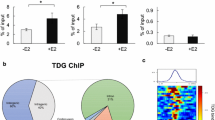Abstract
Estrogen Receptor (ER) is a nuclear receptor that mediates the actions of estrogen and tamoxifen. ER is expressed in a major fraction of human breast cancers. Recently, genomic maps for estrogen- and tamoxifen-ER have been published. Interestingly, estrogen and tamoxifen induce similar genomic interactions and both ligands have been shown to use co-operating factors. The interactions of these co-operating factors within ER regions have impact both on ER-DNA interactions and gene expression regulated by estrogen and tamoxifen. Moreover, the study of chromatin changes induced by these factors has also provided significant insight into our understanding of ER transcriptional regulation. This methods review describes some functional genomic methods to study the influence of both ER ligands and ER co-operating factors. The analysis of protein-DNA interactions and chromatin changes can be explored by using classical and novel methods such as Chromatin Immunoprecipitation (ChIP) or Formaldehyde-Assisted Isolation of Regulatory Elements (FAIRE). This review also explores the properties of each of these methods and the advantages of combining them with high throughput sequencing.


Similar content being viewed by others
Abbreviations
- ER:
-
Estrogen receptor
- ChIP:
-
Chromatin Inmunoprecipitation
- FAIRE:
-
Formaldehyde-Assisted Isolation of Regulatory Elements
- SERM:
-
Selective Estrogen Receptor Modulator
References
Prat A, Baselga J. The role of hormonal therapy in the management of hormonal-receptor-positive breast cancer with co-expression of HER2. Nat Clin Pract Oncol. 2008;5:531.
Duong V, et al. ERalpha and ERbeta expression and transcriptional activity are differentially regulated by HDAC inhibitors. Oncogene. 2006;25:1799.
Frasor J, et al. Profiling of estrogen up- and down-regulated gene expression in human breast cancer cells: insights into gene networks and pathways underlying estrogenic control of proliferation and cell phenotype. Endocrinology. 2003;144:4562.
Hurtado A, Holmes KA, Ross-Innes CS, Schmidt D, Carroll JS. FOXA1 is a key determinant of estrogen receptor function and endocrine response. Nat Genet. 2011;43:27.
Shang Y, Hu X, DiRenzo J, Lazar MA, Brown M. Cofactor dynamics and sufficiency in estrogen receptor-regulated transcription. Cell. 2000;103:843.
Chang EC, Frasor J, Komm B, Katzenellenbogen BS. Impact of estrogen receptor beta on gene networks regulated by estrogen receptor alpha in breast cancer cells. Endocrinology. 2006;147:4831.
Carroll JS, Brown M. Estrogen receptor target gene: an evolving concept. Mol Endocrinol. 2006;20:1707.
Narita M, et al. A novel role for high-mobility group a proteins in cellular senescence and heterochromatin formation. Cell. 2006;126:503.
Schmidt D, et al. ChIP-seq: using high-throughput sequencing to discover protein-DNA interactions. Methods. 2009;48:240.
Hurtado A, et al. Regulation of ERBB2 by oestrogen receptor-PAX2 determines response to tamoxifen. Nature. 2008;456:663.
Robinson JL, et al. Androgen receptor driven transcription in molecular apocrine breast cancer is mediated by FoxA1. EMBO J. 2012;31:1617.
Carroll JS, et al. Genome-wide analysis of estrogen receptor binding sites. Nat Genet. 2006;38:1289.
Lin CY, et al. Whole-genome cartography of estrogen receptor alpha binding sites. PLoS Genet. 2007;3:e87.
Fullwood MJ, et al. An oestrogen-receptor-alpha-bound human chromatin interactome. Nature. 2009;462:58.
Ross-Innes CS, et al. Cooperative interaction between retinoic acid receptor-alpha and estrogen receptor in breast cancer. Genes Dev. 2010;24:171.
Kong SL, Li G, Loh SL, Sung WK, Liu ET. Cellular reprogramming by the conjoint action of ERalpha, FOXA1, and GATA3 to a ligand-inducible growth state. Mol Syst Biol. 2011;7:526.
Lupien M, et al. Growth factor stimulation induces a distinct ER(alpha) cistrome underlying breast cancer endocrine resistance. Genes Dev. 2010;24:2219.
Ross-Innes CS, et al. Differential oestrogen receptor binding is associated with clinical outcome in breast cancer. Nature. 2012;481:389.
Welboren WJ, et al. ChIP-Seq of ERalpha and RNA polymerase II defines genes differentially responding to ligands. EMBO J. 2009;28:1418.
Li H, Ruan J, Durbin R. Mapping short DNA sequencing reads and calling variants using mapping quality scores. Genome Res. 2008;18:1851.
Hinrichs AS, et al. The UCSC genome browser database: update 2006. Nucleic Acids Res. 2006;34:D590.
Zhang Y, et al. Model-based analysis of ChIP-Seq (MACS). Genome Biol. 2008;9:R137.
Saldanha AJ. Java Treeview--extensible visualization of microarray data. Bioinformatics. 2004;20:3246.
Giresi PG, Lieb JD. Isolation of active regulatory elements from eukaryotic chromatin using FAIRE (Formaldehyde Assisted Isolation of Regulatory Elements). Methods. 2009;48:233.
Author information
Authors and Affiliations
Corresponding author
Rights and permissions
About this article
Cite this article
Gilfillan, S., Fiorito, E. & Hurtado, A. Functional Genomic Methods to Study Estrogen Receptor Activity. J Mammary Gland Biol Neoplasia 17, 147–153 (2012). https://doi.org/10.1007/s10911-012-9254-4
Received:
Accepted:
Published:
Issue Date:
DOI: https://doi.org/10.1007/s10911-012-9254-4




